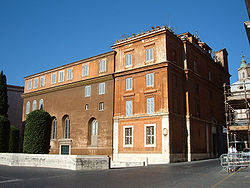- Santa Maria della Pietà in Camposanto dei Teutonici
-
Church of Our Lady of Mercy in the German Cemetery
Santa Maria della Pietà in Camposanto dei Teutonici (Italian)Building complex in which is inserted the National Church in Rome of Austria, Germany, The Netherlands.
Basic information Location  Rome
RomeGeographic coordinates 41°54′4.5″N 12°27′17.6″E / 41.90125°N 12.454889°ECoordinates: 41°54′4.5″N 12°27′17.6″E / 41.90125°N 12.454889°E Affiliation Roman Catholic Year consecrated 1500[1] Ecclesiastical or organizational status National Church in Rome of Austria, Germany, The Netherlands Website Official website Architectural description Architectural type Church Architectural style Baroque Completed XV Century Specifications Length 30 metres (98 ft) Width 18 metres (59 ft) The Church of Our Lady of Mercy in the German Cemetery (Italian: Santa Maria della Pietà in Camposanto dei Teutonici) is a Roman Catholic church in the Vatican City, attached to the Campo Santo dei Teutonici e dei Fiamminghi, the German cemetery in the Vatican City. The site belonged to the Schola Francorum, a hospice for German pilgrims which was the oldest German institution in Rome[2].
The term "Teutonico" is a reference to the Germanic peoples. The church is the National Church in Rome of Austria, Germany, The Netherlands.
History
In 796 Charlemagne, by permission of Pope Leo III, founded on ground adjoining this spot a hospice for pilgrims, which was intended for the people of his empire. In connection with the hospice was a church dedicated to the Saviour and a graveyard for the burial of the subjects of Charlemagne who died in Rome. From the beginning this foundation was placed under the care of the ecclesiastical authorities of St. Peter's. The decline, soon after this period, of the Carolingian empire, brought the hospice, the Schola Francorum, entirely under the jurisdiction of the basilica; at the same time the original intent of a place for pilgrims and the poor was preserved. In the complete ruin which overtook Rome during the residence of the popes at Avignon (1309–1378), and during the following period of the Schism, the ecclesiastical foundations in the vicinity of St. Peter's sank into decay.
After the return of the popes new life sprang up, and the enthusiasm for building and endowing foundations in this part of the Eternal City was rekindled under Popes Martin V, Eugenius IV, and Nicholas V. The remembrance of Charlemagne and his hospice revived in the mind of the large and influential German colony then residing at Rome, and during the reign of Martin V (1417–1431) the enlarged cemetery was surrounded with a wall built by Fredericus Alemannus, who also erected a house for its guardians. During the pest of 1448, Johannis Assonensis, a German confessor attached to St. Peter's and later Bishop of Wurzburg, assembled his countrymen there and founded among them a brotherhood, the object of which was to provide suitable burial for all poor Germans dying in Rome. This brotherhood built a church, a new hospice for German pilgrims on the adjoining land, and developed the Campo Santo into a German national institution.
In the fifteenth, sixteenth, and even in the 19th century the German nation was represented at Rome by numerous officials at the papal court and by guilds of German bakers, shoemakers, and weavers; in these ages Germans were to be found in every industry of ordinary life, and German bankers and inn-keepers were especially numerous. Nevertheless the steadily decreasing German population of Rome during the seventeenth and 18th centuries caused the Campo Santo, as a national foundation, and the brotherhood to sink into neglect.
The church was progressively eclipsed by the church of Saint Maria dell' Anima. In 1876 Pope Pius IX founded a seminary for German speaking priests for the special study of archaeology and Church History to replace the Schola Francorum. Today, the church is still an important gathering place for the German-speaking community in Rome.
Notes
- ^ Grundmann, Stefan (1998). The Architecture of Rome. Stuttgart: Ed. Axel Menges. p. 107. ISBN 3930698609. http://books.google.com/books?id=Se1BbQ99KGUC&hl=en&pg=PA107#v=onepage&q=&f=false.
- ^ Official website of the Vatican City, Teutonic Cemetery
References
 De Waal, Anton (1913). "Campo Santo de' Tedeschi". Catholic Encyclopedia. New York: Robert Appleton Company.
De Waal, Anton (1913). "Campo Santo de' Tedeschi". Catholic Encyclopedia. New York: Robert Appleton Company.- Grundmann, Stefan (1998). The Architecture of Rome. Stuttgart: Ed. Axel Menges. pp. 107–108. ISBN 3930698609. http://books.google.com/books?id=Se1BbQ99KGUC&hl=en&pg=PA107#v=onepage&q=&f=false.
This article incorporates text from the 1913 Catholic Encyclopedia article "
 "Campo Santo de' Tedeschi". Catholic Encyclopedia. 1913." by Anton De Waal, a publication now in the public domain.Categories:
"Campo Santo de' Tedeschi". Catholic Encyclopedia. 1913." by Anton De Waal, a publication now in the public domain.Categories:- National churches in Rome
- Churches in Vatican City
Wikimedia Foundation. 2010.

